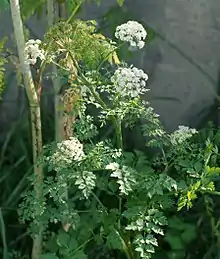Oenanthe (plant)
Oenanthe, known as water dropworts, oenanthes,[2] water parsleys,[3] and water celeries,[4] are a genus of plants in the family Apiaceae. Most of the species grow in damp ground, such as in marshes or in water.
| Oenanthe | |
|---|---|
 | |
| Oenanthe aquatica | |
| Scientific classification | |
| Kingdom: | Plantae |
| Clade: | Tracheophytes |
| Clade: | Angiosperms |
| Clade: | Eudicots |
| Clade: | Asterids |
| Order: | Apiales |
| Family: | Apiaceae |
| Subfamily: | Apioideae |
| Tribe: | Oenantheae |
| Genus: | Oenanthe L. |
| Synonyms[1] | |
|
List
| |

Several of the species are extremely poisonous, the active poison being oenanthotoxin. The most notable of these is O. crocata, which lives in damp, marshy ground, and resembles celery with roots like a bunch of large white carrots. The leaves may be eaten safely by livestock, but the stems, and especially the carbohydrate-rich roots are much more poisonous. Animals familiar with eating the leaves may eat the roots when these are exposed during ditch clearance – one root is sufficient to kill a cow, and human fatalities are also known. It has been referred to as the most poisonous of all British plants,[5] and is considered particularly dangerous because of its similarity to several edible plants.[6]
The species O. javanica, commonly known as Chinese celery or Japanese parsley (seri; not to be confused with mitsuba or Japanese wild celery, Cryptotaenia japonica) is edible and grown in several countries of eastern Asia, as well as in Italy and India, where the spring growth is relished as a vegetable.
Taxonomy and naming
"Oenanthe" is derived from the Greek oinos "wine" and anthos "flower", from the wine-like scent of the flowers.[7]
The name "water dropwort" comes from the close resemblance of some of the smaller species (which mainly grow in wet ground) to dropwort, Filipendula vulgaris (Rosaceae), an unrelated plant of dry grasslands.
Species
As of 2020, Kew's Plants of the World Online accepts 33 species of Oenanthe:[1]
- Oenanthe abchasica Schischk.
- Oenanthe aquatica (L.) Poir.
- Oenanthe banatica Heuff.
- Oenanthe benghalensis (DC.) Miq.
- Oenanthe crocata L.
- Oenanthe cyclocarpa Pimenov & Kljuykov
- Oenanthe fedtschenkoana Koso-Pol.
- Oenanthe fistulosa L.
- Oenanthe fluviatilis (Bab.) Coleman
- Oenanthe foucaudii Tess.
- Oenanthe globulosa L.
- Oenanthe hookeri C.B.Clarke
- Oenanthe incrassans Bory & Chaub.
- Oenanthe incrassata Bory & Chaub.
- Oenanthe javanica (Blume) DC.
- Oenanthe lachenalii C.C.Gmel.
- Oenanthe linearis Wall. ex DC.
- Oenanthe lisae Moris
- Oenanthe mildbraedii H.Wolff
- Oenanthe millefolia Janka
- Oenanthe montis-khortiati Soldano
- Oenanthe palustris (Chiov.) C.Norman
- Oenanthe peucedanifolia Pollich
- Oenanthe pimpinelloides L.
- Oenanthe pringlei J.M.Coult. & Rose
- Oenanthe procumbens (H.Wolff) C.Norman
- Oenanthe prolifera L.
- Oenanthe sarmentosa C.Presl ex DC.
- Oenanthe silaifolia M.Bieb.
- Oenanthe sophiae Schischk.
- Oenanthe thomsonii C.B.Clarke
- Oenanthe tricholoba Greuter
- Oenanthe virgata Poir.
Sardonic grin
Scientists at the University of Eastern Piedmont in Italy wrote that they had identified hemlock water dropwort (Oenanthe crocata) as the plant responsible for producing the sardonic grin.[8][9] This plant is a possible candidate for the "sardonic herb", which was is a neurotoxic plant referred to in ancient histories. It was purportedly used for the ritual killing of elderly people and criminals in Nuragic Sardinia, in which they were intoxicated with the herb and then dropped from a high rock or beaten to death.[10][11]
Fossil record
Oenanthe aquatica fossil fruit halves have been recorded from Upper Miocene of Bulgaria, Pliocene of Thuringia and the Pliocene and Pleistocene of Poland.[12]
Gallery
 Corky-fruited water dropwort (Oenanthe pimpinelloides)
Corky-fruited water dropwort (Oenanthe pimpinelloides) Hemlock water dropwort (Oenanthe crocata) in spring
Hemlock water dropwort (Oenanthe crocata) in spring
References
- "Oenanthe L." Plants of the World Online. Royal Botanic Gardens, Kew. Retrieved 21 August 2020.
- "Pacific Oenanthe, Oenanthe sarmentosa". calscape.org. Retrieved 21 August 2020.
- Brouillet L, Desmet P, Coursol F, Meades SJ, Favreau M, Anions M, Bélisle P, Gendreau C, Shorthouse D, and contributors (2010+). "Oenanthe sarmentosa C. Presl ex de Candolle". data.canadensys.net. Database of Vascular Plants of Canada (VASCAN). Retrieved 21 August 2020.CS1 maint: uses authors parameter (link)
- "Water Celery (Oenanthe javanica)". www.illinoiswildflowers.info. Retrieved 21 August 2020.
- "Information Sheet: 31 Hemlock Water Dropwort (Oenanthe crocata)" (PDF). Centre for Ecology and Hydrology. 2005. Retrieved September 28, 2011.
Oenanthe crocata [...] is the most toxic plant in Britain to both humans and animals.
- Wright, John (2010), Hedgerow, Bloomsbury, p. 171, ISBN 978-1-4088-0185-7
- "Dropwort, Hemlock Water". A Modern herbal. Botanical.com. Retrieved 2008-02-05.
- News Scan Briefs: Killer Smile, Scientific American, August 2009
- G. Appendino; F. Pollastro; L. Verotta; M. Ballero; A. Romano; P. Wyrembek; K. Szczuraszek; J. W. Mozrzymas & O. Taglialatela-Scafati (2009). "Polyacetylenes from Sardinian Oenanthe fistulosa: A Molecular Clue to risus sardonicus". Journal of Natural Products. 72 (5): 962–965. doi:10.1021/np8007717. PMC 2685611. PMID 19245244.
- Appendino, Giovanni; Pollastro, Federica; Verotta, Luisella; Ballero, Mauro; Romano, Adriana; Wyrembek, Paulina; Szczuraszek, Katarzyna; Mozrzymas, Jerzy W.; Taglialatela-Scafati, Orazio (2009-05-22). "Polyacetylenes from Sardinian Oenanthe fistulosa: A Molecular Clue to risus sardonicus". Journal of Natural Products. 72 (5): 962–965. doi:10.1021/np8007717. ISSN 0163-3864. PMC 2685611. PMID 19245244.
- Owen, James (2009-06-02). "Ancient Death-Smile Potion Decoded?". National Geographic News. Archived from the original on 2009-09-18. Retrieved 2009-10-18.
- The Pliocene flora of Kholmech, south-eastern Belarus and its correlation with other Pliocene floras of Europe by Felix Yu. VELICHKEVICH and Ewa ZASTAWNIAK - Acta Palaeobotanica 43(2): 137–259, 2003
External links
- Downs, C.; Phillips, J.; Ranger, A.; Farrell, L. (2002). "A hemlock water dropwort curry: a case of multiple poisoning". Emergency Medicine Journal. 19 (5): 472–473. doi:10.1136/emj.19.5.472. PMC 1725941. PMID 12205016.
